Animal Migration and Climate Change: Changes in The Pattern of Grand Travel
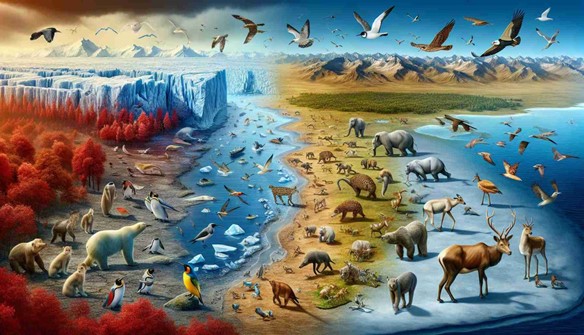
Impact of climate change on wildlife migration patterns (Photo Credit : Scimag)
Migration is a long journey undertaken by animals in search of food, breeding, or finding a more suitable habitat. This phenomenon occurs regularly and often involves thousands of kilometers of travel. Animals such as salmon, humpback whales, sea turtles, and tuna fish have migration paths that have been instinctively programmed for thousands of years. This migration pattern is crucial for the survival of the species and the ecosystems in which they live.
Aquatic animal migration has an important role in maintaining the balance of the ecosystem. As species migrate, they help distribute nutrients and energy along the paths they travel. For example, whales that feed on plankton in the deep ocean then migrate to tropical waters to give birth, bringing essential nutrients to new ecosystems. In addition, migration also ensures successful reproduction, as many species choose certain locations that are safer for laying eggs or giving birth.
Climate change is not only a threat to humans, but also affects the lives of various animal species, including those living in waters. One of the most obvious impacts is the change in animal migration patterns. Migration, which used to take place regularly and consistently, is now disrupted by global warming, changes in ocean currents, and habitat destruction.
This serious threat to migration patterns as a result of climate change causes these animals not only to face long distances, but also to adapt to increasingly uncertain environmental conditions. Water temperatures are rising, ocean currents are changing, and food availability is decreasing. All of this forced them to change the migration path they had known for a long time.
The Impact of Climate Change on Migration Patterns
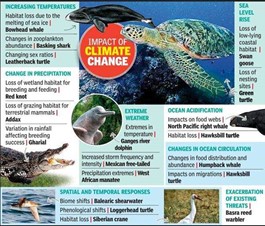
Impact of climate change (Photo Credit : The Times of India)
Climate change has a major impact on the environment, including on the migration patterns of aquatic animals. Here are some of the main factors that affect migration:
- Increased Water Temperature
Global warming is causing sea water temperatures to rise significantly. Many aquatic animal species have a certain temperature tolerance that affects their metabolism and ability to survive. When the water temperature in their native habitat becomes too hot, they are forced to migrate to colder waters. For example, cod, which was once widely found in temperate waters, is now moving to the polar regions.
- Changes in Ocean Currents
Ocean currents are natural guides for many migratory species. However, climate change has caused shifts in ocean current patterns due to melting polar ice and changes in water salinity. This causes aquatic animals to have difficulty finding their migration paths, which in turn affects the success of their journey.
- Habitat Destruction
Habitats such as coral reefs and seagrass meadows that are important places for species to feed or breed are now facing serious threats. Coral reef bleaching due to global warming has damaged the ecosystems that are home to many species of reef fish. This forces these animals to look for new, safer habitats.
- Disruptions in the Food Chain
Climate change is affecting the distribution of plankton, small fish, and other organisms that are the main food of large animals such as whales and sharks. As these food sources move, predatory species must also adjust their migration paths to survive.
- Migration Time Mismatch
Seasonal changes due to climate change also affect migration times. For example, if spring comes early, migratory animals may arrive too early or late at their destination, thus missing out on opportunities to breed or forage optimally.
Examples of Migrations Affected by Climate Change
- Humpback Whale
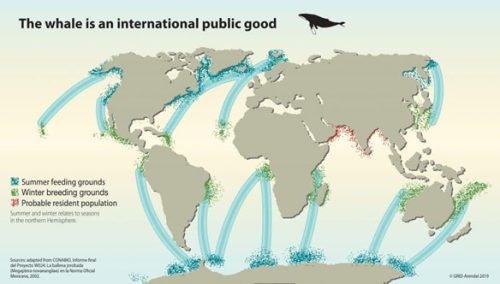
Photo Credit : Adapted from CONABIO, Final Report of Project W024: The Humpback Whale (Megaptera novaeangliae) in the Official Mexican Standard, 2002.
Humpback whales are known for their long migration journeys from the polar regions to tropical waters to give birth. However, changes in ocean currents and declining plankton populations affected their food availability, making their travel more difficult and less efficient.
- Salmon
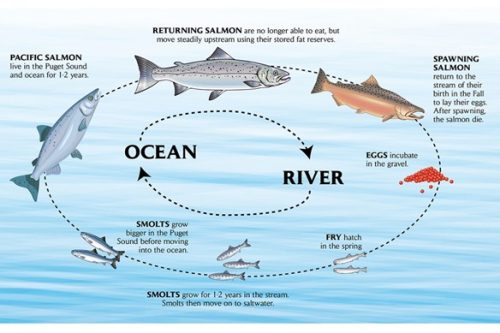
Photo Credit : Washington Forest Protection Association
Salmon migrate from the sea to freshwater rivers to lay eggs. Rising water temperatures in these rivers can jeopardize the survival of their eggs, putting salmon populations at risk.
- Sea Turtle
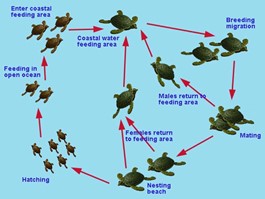
Photo Credit : Marine Education Society of Australasia
Sea turtles, like green turtles, migrate to certain beaches to lay their eggs. However, changes in sand temperature on the beach affect the sex ratio of baby turtles, which depends on the incubation temperature. This can disrupt the long-term population balance.
Migration as an Indicator for Mitigation
Animal migration patterns are not only important for their survival, but they can also be a valuable indicator for understanding the impacts of climate change. Here are some ways migration can be leveraged for mitigation:
- Bioindicators of Environmental Change
Migration patterns can reflect changes in water temperature, salinity, and food availability. If the migration path of animals changes drastically, it could be a sign of a major problem in the marine ecosystem. By studying these patterns, we can identify areas that need immediate protection.
- Conservation of Migration Pathways
Protecting migration routes through marine protected areas (MPAs) can help species survive. MPAs can be designed to protect the critical routes that animals use during migration.
- Tracking Technology
Tools such as satellite tagging are used to track the movements of species such as whales and turtles. This data helps scientists understand changing migration patterns and identify threats faced by the species.
- Data-Driven Climate Policy
Information on migration can be used to design more effective climate policies. For example, sustainable fisheries management can be adapted to the migration patterns of target species to reduce pressure on their populations.
Mitigation Measures to Protect Migratory Animals
Here are some steps that can be taken to protect migratory animals and their ecosystems:
- Protect Critical Habitats: Maintaining ecosystems such as coral reefs, mangrove forests, and seagrass meadows can help provide shelter and food for migratory animals.
- Reduce Carbon Emissions: Global efforts to reduce greenhouse gas emissions are key to slowing climate change and its impact on animals.
- Marine Area Conservation: Establishing marine conservation areas along important migration routes can protect species during their journey.
- Education and Awareness: Raising public awareness about the importance of animal migration and its impact on ecosystems can help support conservation efforts.
- Monitoring and Research: Conducting long-term research on migration patterns can provide valuable insights for climate change mitigation.
Conclusion
Migration as a Mirror of Climate Change, Aquatic animal migration is an important part of marine life and global ecosystems. However, climate change threatens this migration pattern in an unprecedented way. By studying and protecting migration pathways, we can understand more about the impacts of climate change and take better mitigation measures. Ultimately, protecting these animals means protecting the future of our planet.
Migration patterns provide valuable insights into how our environment is changing, while also reminding us that all living things on the planet are interconnected. Through conservation efforts and wise climate policies, we can help maintain the balance of ecosystems and biodiversity amid these global challenges.
-Yuni Sulaiman

